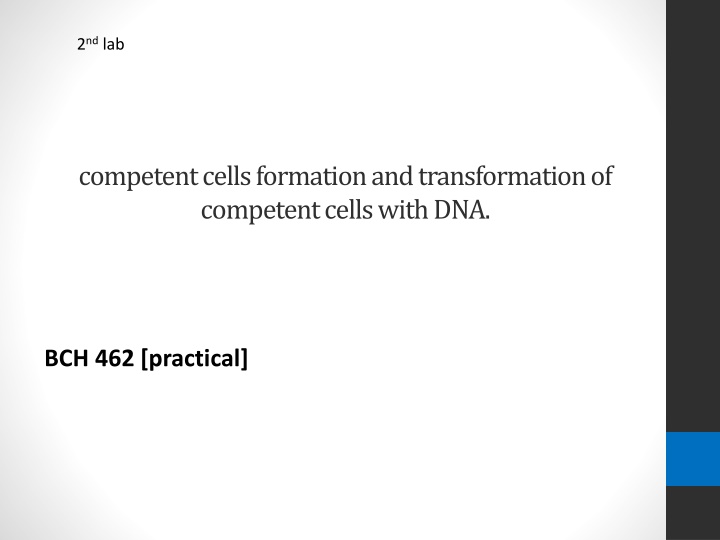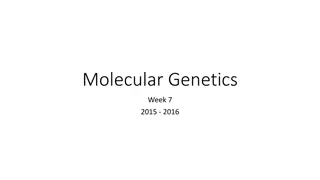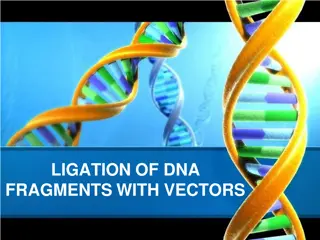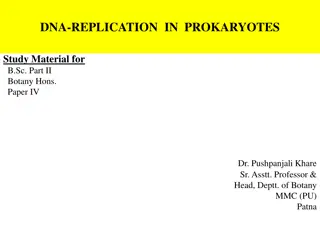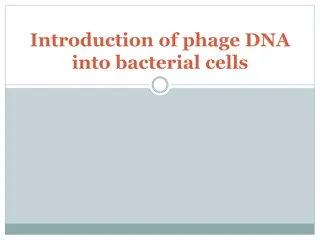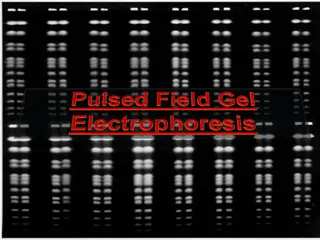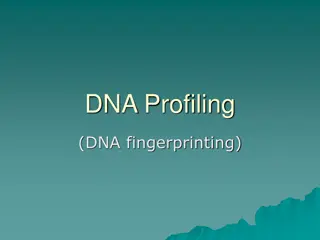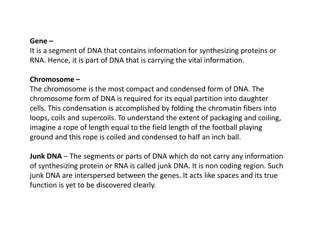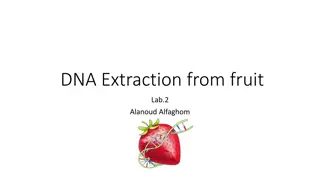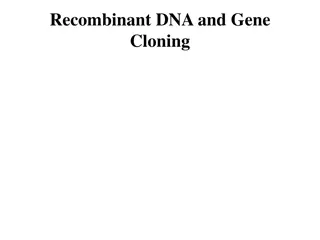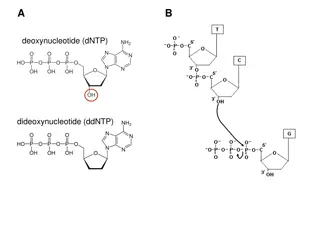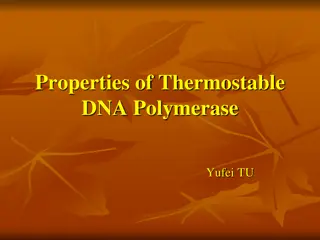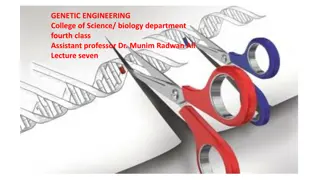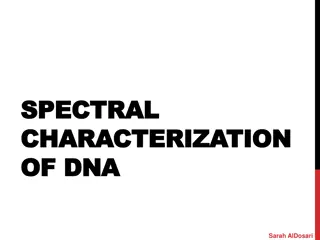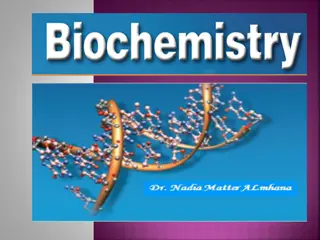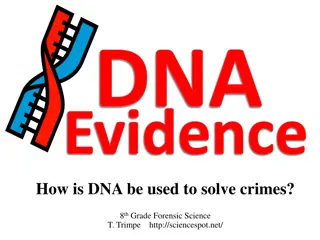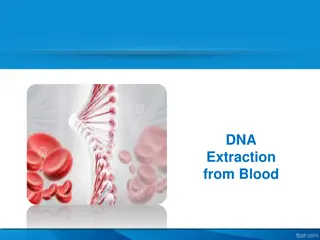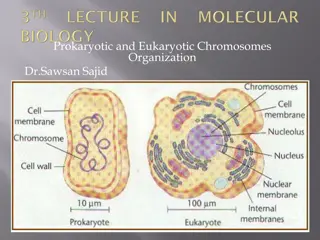competent cells formation and transformation of competent cells with DNA.
This practical guide covers the formation and transformation of competent cells with DNA, DNA cloning involving the insertion of DNA fragments into plasmids, the role of restriction endonucleases, DNA ligase, and the use of cloning vectors. Learn about the essential components required for successful DNA cloning procedures.
Download Presentation

Please find below an Image/Link to download the presentation.
The content on the website is provided AS IS for your information and personal use only. It may not be sold, licensed, or shared on other websites without obtaining consent from the author.If you encounter any issues during the download, it is possible that the publisher has removed the file from their server.
You are allowed to download the files provided on this website for personal or commercial use, subject to the condition that they are used lawfully. All files are the property of their respective owners.
The content on the website is provided AS IS for your information and personal use only. It may not be sold, licensed, or shared on other websites without obtaining consent from the author.
E N D
Presentation Transcript
2ndlab competent cells formation and transformation of competent cells with DNA. BCH 462 [practical]
DNA cloning involve: cell based 1.Insertion of DNA fragments in to a cloning vector e.g. plasmid . 2.Introducing a vector in to bacterial cells the host . 3.Amplifying the vector DNA using bacterial DNA replication machinery. 1 DNA fragment cloning vector Recombinant DNA 2 Recombinant DNA the host Transformed bacteria 3
Origin of replication Anti-bacterial resistance gene. e.g: ampicillin resistance gene. Generally plasmid vectors should contain three important parts.
At least one R.E recognition sites EcoR1 Bam H1 e.g: ampicillin resistance gene Hind III Generally plasmid vectors should contain three important parts.
Restriction endonucleases Enzymes[R.E]: Are DNA-cutting enzymes found in bacteria (and harvested from them for use). Because they cut within the molecule, they are often called restriction endonucleases. Restriction Enzyme, e.g: EcoR1
DNA ligase: is a specific type of enzyme, that facilitates the joining of DNA strands together by catalyzing the formation of a phosphodiester bond.
Using same R.E used For cutting gene A Using R.E Animal DNA gene A gene A DNA cloning using plasmid 1 Ligation [using ligase enzymes] 2 Bacterial cell Introducing 3 cloning Chromosomal DNA Culture plate [media containing appropriate antibiotic ] Amplified Recombinant plasmid Transformed bacteria
What is cloning vector? A DNA molecule that carries foreign DNA into a host cell, replicates inside a bacterial cell and produces many copies of itself and the foreign DNA. They must be: 1. capable of independent replication within the bacterial host cells . 2. they most contain at least one specific nucleotide sequence recognized by a restriction endonuclease. Tow major types of cloning vector can be found in bacterial cells they are: -plasmid. -bacteriophages.
Bacteria in general can acquire new genetic information by: 1.During conjugation direct contact. Conjugation: DNA is transferred directly from one organism to another and it requires direct cell-cell contact.
2.Transduction bacteriophages Transduction: is the process by which DNA is transferred from one bacterium to another by a virus[bacteriophges].
Introducing Bacterial cell Chromosomal DNA Transformed bacteria 3.Transformation DNA, plasmid DNA Transformation: acquisition of extracellular DNA from the environment.
-Competence is the ability of a cell to take up extracellular ("naked") DNA from its environment. -It is the ability to undergo transformation, which means the ability of a cell to take the DNA from the environment. -There are: Natural competence: a genetically specified ability of bacteria that is occur under natural condition. Artificial competence: when cells in laboratory cultures are treated to be permeable to DNA.
Methods of transformation: http://upload.wikimedia.org/wikipedia/commons/thumb/a/a2/Gemini_X2_generator.jpg/220px-Gemini_X2_generator.jpg File:Electroporation Cuvettes.jpg 1. Electroporation, or Electropermeabilization
2.Chemical transformation. Less efficient than electroporation. Insertion 1.CaCl2 treatment To permeabilize the bacterial cell membrane 2.Brief heat shock to facilitate The DNA up take. Transformed bacteria
Competent Cells formation and transformation of competent Cells with DNA Principle of the experiment: chemical transformation method Cells are incubated in CaCl2 solution that help the cells to take up the DNA plasmid by increasing the bacterial cell s membranes permeability [renders them competent to take up DNA], then applying brief heat shock will facilitate the DNA up take. Note: the transformed cells are then grown in LB agar plate containing appropriate antibiotic to be able to count the transformed colonies only , which they are colonies containing transformed cells -containing the DNA plasmid- , each colony on an antibiotic plate presents a single transformation event. -Then calculations of the transformation efficiency will be done.
Principle of the experiment: [Chemical transformation] Insertion Competent Bacterial cell 1.CaCl2 treatment To permeabilize the bacterial cell membrane 2.Brief heat shock to facilitate The DNA up take. Transformed bacteria
3.Positive selection on LB plates with the appropriate antibiotic. Transformation efficiency= total number of colonies on LB/Amp plate CFU/ g amount of DNA plated [ g/ml] CFU: colony forming units.
Animation: http://www.dnai.org/b/index.html Principle of chemical transformation : http://www.dnalc.org/resources/animations/transformation2.html Mechanism of Recombination: http://www.dnalc.org/resources/3d/20-mechanism-of-recombination.html
